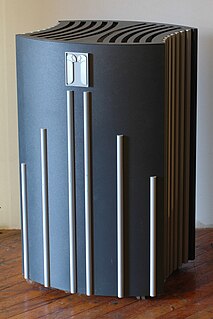Related Research Articles

The VHSIC Hardware Description Language (VHDL) is a hardware description language (HDL) that can model the behavior and structure of digital systems at multiple levels of abstraction, ranging from the system level down to that of logic gates, for design entry, documentation, and verification purposes. Since 1987, VHDL has been standardized by the Institute of Electrical and Electronics Engineers (IEEE) as IEEE Std 1076; the latest version of which is IEEE Std 1076-2019. To model analog and mixed-signal systems, an IEEE-standardized HDL based on VHDL called VHDL-AMS has been developed.
Verilog, standardized as IEEE 1364, is a hardware description language (HDL) used to model electronic systems. It is most commonly used in the design and verification of digital circuits at the register-transfer level of abstraction. It is also used in the verification of analog circuits and mixed-signal circuits, as well as in the design of genetic circuits. In 2009, the Verilog standard was merged into the SystemVerilog standard, creating IEEE Standard 1800-2009. Since then, Verilog is officially part of the SystemVerilog language. The current version is IEEE standard 1800-2017.
In computer engineering, a hardware description language (HDL) is a specialized computer language used to describe the structure and behavior of electronic circuits, and most commonly, digital logic circuits.
Electronic design automation (EDA), also referred to as electronic computer-aided design (ECAD), is a category of software tools for designing electronic systems such as integrated circuits and printed circuit boards. The tools work together in a design flow that chip designers use to design and analyze entire semiconductor chips. Since a modern semiconductor chip can have billions of components, EDA tools are essential for their design; this article in particular describes EDA specifically with respect to integrated circuits (ICs).
In the context of hardware and software systems, formal verification is the act of proving or disproving the correctness of intended algorithms underlying a system with respect to a certain formal specification or property, using formal methods of mathematics.

SystemVerilog, standardized as IEEE 1800, is a hardware description and hardware verification language used to model, design, simulate, test and implement electronic systems. SystemVerilog is based on Verilog and some extensions, and since 2008 Verilog is now part of the same IEEE standard. It is commonly used in the semiconductor and electronic design industry as an evolution of Verilog.
Specman is an EDA tool that provides advanced automated functional verification of hardware designs. It provides an environment for working with, compiling, and debugging testbench environments written in the e Hardware Verification Language. Specman also offers automated testbench generation to boost productivity in the context of block, chip, and system verification.

Integrated circuit design, or IC design, is a sub-field of electronics engineering, encompassing the particular logic and circuit design techniques required to design integrated circuits, or ICs. ICs consist of miniaturized electronic components built into an electrical network on a monolithic semiconductor substrate by photolithography.
In electronic design automation, functional verification is the task of verifying that the logic design conforms to specification. In everyday terms, functional verification attempts to answer the question "Does this proposed design do what is intended?" This is a complex task, and takes the majority of time and effort in most large electronic system design projects. Functional verification is a part of more encompassing design verification, which, besides functional verification, considers non-functional aspects like timing, layout and power.

In integrated circuit design, hardware emulation is the process of imitating the behavior of one or more pieces of hardware with another piece of hardware, typically a special purpose emulation system. The emulation model is usually based on a hardware description language source code, which is compiled into the format used by emulation system. The goal is normally debugging and functional verification of the system being designed. Often an emulator is fast enough to be plugged into a working target system in place of a yet-to-be-built chip, so the whole system can be debugged with live data. This is a specific case of in-circuit emulation.
Electronic system level (ESL) design and verification is an electronic design methodology, focused on higher abstraction level concerns. The term Electronic System Level or ESL Design was first defined by Gartner Dataquest, an EDA-industry-analysis firm, on February 1, 2001. It is defined in ESL Design and Verification as: "the utilization of appropriate abstractions in order to increase comprehension about a system, and to enhance the probability of a successful implementation of functionality in a cost-effective manner."
Intel Quartus Prime is programmable logic device design software produced by Intel; prior to Intel's acquisition of Altera the tool was called Altera Quartus Prime, earlier Altera Quartus II. Quartus Prime enables analysis and synthesis of HDL designs, which enables the developer to compile their designs, perform timing analysis, examine RTL diagrams, simulate a design's reaction to different stimuli, and configure the target device with the programmer. Quartus Prime includes an implementation of VHDL and Verilog for hardware description, visual editing of logic circuits, and vector waveform simulation.
e is a hardware verification language (HVL) which is tailored to implementing highly flexible and reusable verification testbenches.
Aldec, Inc. is a privately owned electronic design automation company based in Henderson, Nevada that provides software and hardware used in creation and verification of digital designs targeting FPGA and ASIC technologies.
Tensilica Instruction Extension refers to the proprietary language that is used to customize Tensilica's Xtensa processor core architecture.
High-level synthesis (HLS), sometimes referred to as C synthesis, electronic system-level (ESL) synthesis, algorithmic synthesis, or behavioral synthesis, is an automated design process that takes an abstract behavioral specification of a digital system and find a register-transfer level structure that realizes the given behavior.
Analog verification is a methodology for performing functional verification on analog, mixed-signal and RF integrated circuits and systems on chip. Discussion of analog verification began in 2005 when it started to become recognized that the analog portion of large mixed-signal chips had become so complex that a significant and ever increasing number of these chips were being designed with functional errors in the analog portion that prevented them from operating correctly.
Catapult C Synthesis, a commercial electronic design automation product of Mentor Graphics, is a high-level synthesis tool, sometimes called algorithmic synthesis or ESL synthesis. Catapult C takes ANSI C/C++ and SystemC inputs and generates register transfer level (RTL) code targeted to FPGAs and ASICs.
High-level verification (HLV), or electronic system-level (ESL) verification, is the task to verify ESL designs at high abstraction level, i.e., it is the task to verify a model that represents hardware above register-transfer level (RTL) abstract level. For high-level synthesis, HLV is to HLS as functional verification is to logic synthesis.
Random testing is a black-box software testing technique where programs are tested by generating random, independent inputs. Results of the output are compared against software specifications to verify that the test output is pass or fail. In case of absence of specifications the exceptions of the language are used which means if an exception arises during test execution then it means there is a fault in the program, it is also used as a way to avoid biased testing.
References
- "Mentor offers 'intelligent' testbench generation tool", SDCSource, Feb 18, 2008.
- "Nusym focuses on intelligent verification" EETimes, May 2008.
- "Lifting the Fog on Intelligent Verification", SCDSource, May 2008.